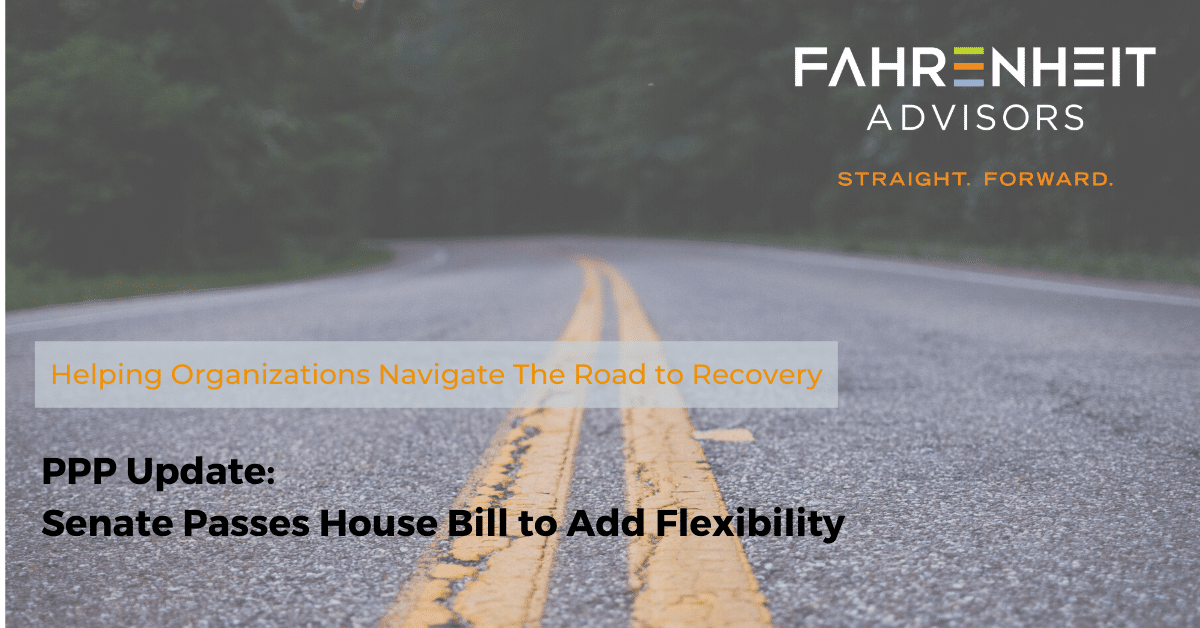PPP Update: Senate Passes House Bill to Add Flexibility

On the evening of June 3rd, the Senate passed the same bill that the House passed last week (H.R. 7010) to add flexibility to the Payroll Protection Program. It now goes to the President for signing.
The main provisions are:
- Extension of time to use PPP funds and qualify for forgiveness from 8 weeks to 24 weeks from receipt of PPP loan or December 31, 2020 (whichever one is earlier). Borrowers may still elect to use the 8 week covered period. Note: extending to 24 weeks could impact the amount of forgiveness if the company reduces FTE’s during the period. In addition, there is already discussion from regulators that it may be interpreted as an 8 to 10 week period during the 24 week period. More to follow.
- Reduction in the requirement that 75% of the amount of loan forgiveness needs to be used for payroll costs down to 60%. Note: the amendment refers to a “cliff”, meaning if more than 40% of the loan is used for nonpayroll costs none of the loan will be forgiven (versus just a reduction in the prior guidance). This may be a drafting error.
- New PPP loans will have a minimum maturity of 5 years for the unforgiven portion. Lenders of prior PPP loans can elect to extend the maturity of the current maturity of 2 years to 5 years.
- The deferral period for initial loan payments has been extended from 6 months to 12.
- PPP borrowers can now use the 24 week period to restore their workforce levels and wages and must be done by December 31st, versus the previous deadline of June 30th.
- Two new exceptions allow borrowers to achieve full PPP loan forgiveness even if they don’t fully restore their workforce. Previous guidance already allowed borrowers to exclude from those calculations employees who turned down good faith offers to be rehired at the same hours and wages. The new bill allows borrowers to avoid forgiveness reduction if they could not find qualified employees or were unable to restore business operations to Feb. 15, 2020-levels due to COVID-19 related operating restrictions. More guidance will be needed to define these exceptions.
- PPP borrowers may now utilize the payroll tax deferral options permitted under the CARES Act. Remember, this is a deferral and not forgiveness.
While I am optimistic that these provisions will ultimately become law, I would be remiss if I did not point out the following:
- As mentioned above, the President needs to sign for this to become law.
- As we have seen in the past, the SBA and the Treasury have been willing to add their own spin to laws passed by Congress. Part of the reason that this bill had to be passed in the first place was the SBA’s invention of the 75% rule. So we all need to stay on top of future guidance issued on these matters.
Let me know how Fahrenheit Advisors can help you.
Due to the rapidly changing regulations and program specifics, some items in this post may have changed since the publication date. Companies should continue to monitor the US Treasury and SBA websites for updates.
About the Author
Doug Jones provides fractional CFO and senior financial management services to small and midsize organizations. In addition to improving his clients’ accounting and finance operations, Doug frequently serves as the link between company owners and outside advisors including attorneys, CPAs, investment bankers, appraisers, and personal financial advisors. He is skilled in identifying and integrating the full range of financial and non-financial business issues in contract negotiations and resolution of business decisions.
